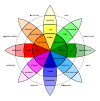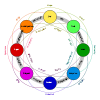Psychomotor agitation
Psychomotor agitation is a spectrum of disorders characterized by unintentional and purposeless motions and restlessness, often accompanied by emotional distress, but not always. Typical manifestations include pacing around a room, wringing the hands, uncontrolled tongue movement, pulling off clothing and putting it back on, and other similar actions. In more severe cases, the motions may become harmful to the individual, such as ripping, tearing, or chewing at the skin around one's fingernails, lips, or other body parts to the point of bleeding. Psychomotor agitation is typically found in major depressive disorder or obsessive-compulsive disorder, and sometimes the manic phase in bipolar disorder, though it can also be a result of an excess intake of stimulants. It can also be caused by severe hyponatremia. The middle-aged and the elderly are more at risk to express it.
| Psychomotor agitation | |
|---|---|
| Specialty | Psychiatry, emergency medicine |
Symptoms
People experiencing psychomotor agitation may feel or do:
- unable to sit still
- fidgeting
- as if their body is stiff
- unable to relieve tension
- desperate to find a comfortable position
- increasingly anxious
- exasperated
- tearful
- extreme irritability, like snapping at friends and family, or being annoyed at small things
- anger
- agitation
- racing thoughts and incessant talking
- restlessness
- pacing
- hand-wringing
- nail-biting
- outbursts of complaining or shouting
- pulling at clothes or hair
- picking at skin
- pace around a room
- tap their fingers
- tap their feet
- start and stop tasks abruptly
- talk very quickly
- move objects around for no reason
- take off clothes then put them back on
Causes
Causes include:[1]
- Schizophrenia
- Bipolar disorder
- Excited delirium
- Post-traumatic stress disorder (PTSD)
- Panic attacks
- Anxiety disorder
- Obsessive-compulsive disorder (OCD)
- Alcohol withdrawal
- Claustrophobia
- Dementia
- Parkinson's disease
- Traumatic brain injury
- Alzheimer's disease[2]
- Acute intermittent porphyria[3]
- Hereditary coproporphyria
- Variegate porphyria
- Side effects of drugs like cocaine or methylphenidate
- Side effects of antipsychotics like haloperidol
- Major depressive disorder [4]
- Agitated depression [4]
- SSRI or SNRI medications
As explained in a 2008 study, in people with mood disorders there is a dynamic link between their mood and the way they move.[5]
People showing signs of psychomotor agitation may be experiencing mental tension and anxiety, which comes out physically as:
- fast or repetitive movements
- movements that have no purpose
- movements that are not intentional
These activities are the subconscious mind's way of trying to relieve tension. Often people experiencing psychomotor agitation feel as if their movements are not deliberate.
Sometimes, however, psychomotor agitation does not relate to mental tension and anxiety.
A 2010 study found that there was also a link between psychomotor agitation and nicotine, alcohol, and drug dependence.
In other cases, psychomotor agitation can be caused by antipsychotic medications.
Treatment
Intramuscular midazolam, lorazepam, or another benzodiazepine can be used to both sedate agitated patients, and control semi-involuntary muscle movements in cases of suspected akathisia.
Droperidol, haloperidol, or other typical antipsychotics can decrease the duration of agitation caused by acute psychosis, but should be avoided if the agitation is suspected to be akathisia, which can be potentially worsened.[6] Also using promethazine may be useful.[7] Recently, three atypical antipsychotics, olanzapine, aripiprazole and ziprasidone, have become available and FDA approved as an instant release intramuscular injection formulations to control acute agitation. The IM formulations of these three atypical antipsychotics are considered to be at least as effective or even more effective than the IM administration of haloperidol alone or haloperidol with lorazepam[8][9][10] (which is the standard treatment of agitation in most hospitals) and the atypicals have a dramatically improved tolerability due to a milder side-effect profile.
In those with psychosis causing agitation there is a lack of support for the use of benzodiazepines alone, however they are commonly used in combination with antipsychotics since they can prevent side effects associated with dopamine antagonists.[11]
Also, introducing the following lifestyle changes to their routine may help a person to reduce their anxiety levels:[5]
- regular exercise
- yoga and meditation
- deep breathing exercises
See also
- Agitation (dementia)
- Akathisia
- Body-focused repetitive behavior
- Excited delirium
References
- Causes of Psychomotor agitation Archived 2016-03-11 at the Wayback Machine, Retrieved 11 March 2016.
- Koenig, AM; Arnold, SE; Streim, JE (January 2016). "Agitation and Irritability in Alzheimer's Disease: Evidenced-Based Treatments and the Black-Box Warning". Current Psychiatry Reports. 18 (1): 3. doi:10.1007/s11920-015-0640-7. PMC 6483820. PMID 26695173.
- "Acute Intermittent Porphyria (AIP)". American Porphyria Foundation. 18 February 2009. Retrieved 8 December 2017.
- "Agitated Depression: Symptoms, Treatment, and Outlook". Healthline. Retrieved 31 July 2018.
- "What is psychomotor agitation?".
- Isbister GK, Calver LA, Page CB, Stokes B, Bryant JL, Downes MA (October 2010). "Randomized controlled trial of intramuscular droperidol versus midazolam for violence and acute behavioral disturbance: the DORM study". Ann Emerg Med. 56 (4): 392–401.e1. doi:10.1016/j.annemergmed.2010.05.037. PMID 20868907.
- Ostinelli, EG; Brooke-Powney, MJ; Li, X; Adams, CE (31 July 2017). "Haloperidol for psychosis-induced aggression or agitation (rapid tranquillisation)". The Cochrane Database of Systematic Reviews. 7: CD009377. doi:10.1002/14651858.CD009377.pub3. PMC 6483410. PMID 28758203.
- Huang, Charles Lung-Cheng; Hwang, Tzung-Jeng; Chen, Yi-Hsing; Huang, Guan-Hua; Hsieh, Ming H.; Chen, Hsiu-Hsi; Hwu, Hai-Gwo (May 2015). "Intramuscular olanzapine versus intramuscular haloperidol plus lorazepam for the treatment of acute schizophrenia with agitation: An open-label, randomized controlled trial". Journal of the Formosan Medical Association = Taiwan Yi Zhi. 114 (5): 438–445. doi:10.1016/j.jfma.2015.01.018. ISSN 0929-6646. PMID 25791540.
- Citrome, L.; Brook, S.; Warrington, L.; Loebel, A.; Mandel, F.S. (October 2004). "Ziprasidone versus haloperidol for the treatment of agitation". Annals of Emergency Medicine. 44 (4): S22. doi:10.1016/j.annemergmed.2004.07.073. ISSN 0196-0644.
- Cañas, Fernando (March 2007). "Management of agitation in the acute psychotic patient — Efficacy without excessive sedation". European Neuropsychopharmacology. 17: S108–S114. doi:10.1016/j.euroneuro.2007.02.004. ISSN 0924-977X. PMID 17336765.
- Gillies, D; Sampson, S; Beck, A; Rathbone, J (30 April 2013). "Benzodiazepines for psychosis-induced aggression or agitation". The Cochrane Database of Systematic Reviews. 4 (4): CD003079. doi:10.1002/14651858.CD003079.pub3. PMID 23633309.

